TV’s first feature-length animated film and its companion pop storybook album, all about a kingdom where all things were required to have points, happened in a roundabout way.
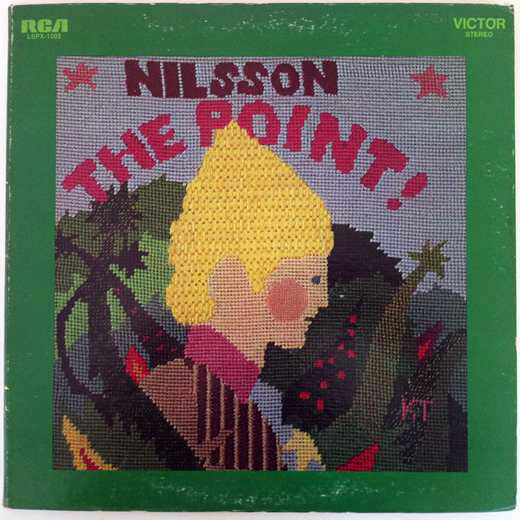
THE POINT
Nilsson
RCA Victor Records LSPX-1003 (12” 33 1/3 RPM LP / Stereo)
CD Reissues: CDD/BMG Special Products (1998); RCA Legacy Family Artist Series 07863651282 (2002)
Currently available for streaming and download

Released in 1971. Producer/Writer/Narrator: Harry Nilsson. Arranger/Conductor: George Tipton. Engineer: Ritchie Schmitt. Technical Engineer: Dennis Smith/ Contributing Engineers & Technicians: Mike Leary, Hank McGill, Kent Tunks, Frank Trupia, Pat Ieraci. Album Design: Dean Torrance. Cover Needlepoint: Kathy Torrance. Storybook Illustrations: Gary Lund. Productions Secretary: Marge Meoli. Special Thanks: Murakami-Wolf Films. Running Time: 32 minutes.
Songs: “Everything’s Got ‘Em,” “Me and My Arrow,” “Poli High,” “Think About Your Troubles,” “Life Line,” “P.O.V. Waltz,” “Are You Sleeping?” by Harry Nilsson.
Story Segments: “The Town,” “The Game,” “The Trial & Banishment,” “The Painted Man,” “The Birds,” “The Clearing in the Woods,” “Oblio’s Return” by Harry Nilsson.
The ABC-TV network ran The Point on February 2, 1971, on the Movie of the Week, a series of 90-minute “world premiere movies” that were descendants of the live and filmed anthologies of television and the “B” movies of Hollywood. Each Tuesday (and later Wednesday), a new movie would air that was “created especially for ABC” just as each new episode of the anthology series Suspense had been “especially created for radio” in the 1940s.
Movie of the Week was such a huge success, for a while these TV-movies moved into syndication and briefly nudged out theatrical features with lower costs and proven ratings that made them attractive to stations. The memorable Movie of the Week theme music had been previously recorded by Burt Bacharach as “Nikki,” an instrumental named for his daughter.
Like the low-budget films it emulated, Movie of the Week could be frothy comedies, tear-jerking dramas or suspense thrillers, but also occasional opportunities to showcase new talent, explore new themes or experiment with the form. One of the most famous was Steven Spielberg’s Duel, an unsettling battle of wits between the driver of a car (Dennis Weaver) and an unseen adversary behind an 18-wheel truck. Like Walt Disney’s Davy Crockett and Zorro episodes(as well as The Point), it was released to theaters after its broadcast.
Harry Nilsson was as much a planner and entrepreneur as he was a musician, singer and songwriter. The Point was not some idle, capricious lark but a result of ideas he had been kicking around for a long while, in hopes of putting together an innovative musical property. In a documentary called “Nilsson on Screen” included with the recently released 50th anniversary Blu-ray of The Point, biographer Alyn Shipton details how Nilsson had been developing a musical about the Wright Brothers with several of the musical and visual concepts that ended up being used in The Point.
Nilsson had also been doing some very unusual and interesting things with film and television narrative conventions. He sang every word of the end credits (even the legal disclaimer) in what was what many consider the only instance of wit in the otherwise “so-bad-it’s-unbelievable” 1968 generation gap comedy feature Skidoo. He also created a “Greek chorus” of sorts for the popular ABC sitcom The Courtship of Eddie’s Father, singing a few words in various scenes to comment on the action. The theme for the series was a rewrite of a previous song called “My Girlfriend.”
When he did finally arrive at the decision to create a story about a round-headed little boy treated as an outcast in a mythical kingdom of points, he wrote an illustrated story with about a dozen pages. Hanna-Barbera was approached to produce it as an animated film but negotiations broke down, according to actor Curtis Armstrong (Revenge of the Nerds, Supernatural), also a Nilsson historian who wrote the liner notes for RCA’s 2002 CD reissue of The Point. Once Fred Wolf (who shared his experiences in this Animation Spin about another TV landmark, Free to Be… You and Me, for this Animation Spin), was on board, the entire project began to take shape. Wolf assigned author Carole Beers to work with Nilsson on a treatment that would include characters like The Pointed Man, Balloon Ladies, The Rockman and so forth.
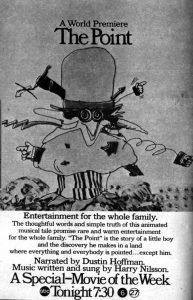 The fact that Nilsson felt it necessary to take his highly unique—and risky—pitch to the top executive at ABC seems neither naïveté nor hubris, but strategic savvy. Though a sharp exec on a lower rung than Martin Starger would have seen the potential in touting the first film of its kind, an album tie-in and other potential angles, it still has a very “underground” feel for 90 minutes of 1971 network time (Yellow Submarine would not premiere on CBS until October 1972, thanks for asking). Having a champion as the top assured support of an eyebrow-raising project.
The fact that Nilsson felt it necessary to take his highly unique—and risky—pitch to the top executive at ABC seems neither naïveté nor hubris, but strategic savvy. Though a sharp exec on a lower rung than Martin Starger would have seen the potential in touting the first film of its kind, an album tie-in and other potential angles, it still has a very “underground” feel for 90 minutes of 1971 network time (Yellow Submarine would not premiere on CBS until October 1972, thanks for asking). Having a champion as the top assured support of an eyebrow-raising project.
Throughout the production, with Fred Wolf in a constant flurry to get it done, mostly working at night and sleeping days. Beers, who helped develop the story and characters with Nilsson for the treatment, was steering the narrative into science fiction. Nilsson, protective of his concept, was not pleased, so Wolf brought in scriptwriter Norm Lenzer. Interviewed on the Blu-ray, Lenzer explains Wolf had already started production before there was a script. Lenzer’s task was to give the characters their quirky personalities, in collaboration with Wolf and under the approval of Nilsson. Not only had Lenzer worked with Wolf, but both had done many projects with legendary voice actors Paul Frees, Joan Gerber and Lennie Weinrib. The Point now had a collective voice that was wry, quirky and unconventional for longform TV animation .
In the early ‘70s context of Saturday morning TV, the voices of these three actors were ubiquitous, but their acting approaches in The Point were markedly different than what was usually heard in video animation, more akin to the understated manner in which Wes Anderson directed his cast in Fantastic Mr. Fox. Fred Wolf asked Lenzer to direct the actors, and those familiar with regional radio advertising of the late ‘60s will recognize the modulated, mellow comic tone of the direction.
 The film voices were recorded at Bell Sound in Hollywood, while Nilsson sang and narrated his album at RCA and A&M Studios (coincidentally the first Hanna-Barbera studio). The voice actors never made their way to a dialogue soundtrack album and only exist within the film.
The film voices were recorded at Bell Sound in Hollywood, while Nilsson sang and narrated his album at RCA and A&M Studios (coincidentally the first Hanna-Barbera studio). The voice actors never made their way to a dialogue soundtrack album and only exist within the film.
Dustin Hoffman agreed to a very small fee to narrate the first ABC broadcast, His asking price was too high for the ABC rerun so his track was replaced with that of actor Alan Barzman (this may have been the original scratch track, according to Lenzer, who prefers this version). Nilsson’s longtime friend Ringo Starr narrated it for home video (which is the way it is heard on the Blu-ray). Alan Thicke recorded it for cable.
The music and the film were produced, more or less, on parallel roads with each other, though of course the audio had to be done first. One of the ways Wolf saves time was to skip the pencil test process and go directly to ink-and-paint, another risk that resulted in an even more loose, unique-looking finished product. According to Lenzer, Jimmy Murakami had already gone mostly into a live-action film, Chuck Swenson was just beginning to be part of the company and so, in his observation, the entire film was done very rapidly by Wolf and his small staff.
The resulting film was extremely well received and the song “Me and My Arrow” was released as a hit single. It made the bizarre leap so many surreal, avant-garde things did in those strange, contradictory days—it ended up in a rather ordinary, conventional TV commercial.
Besides writers like Carole Beers and Norm Lenzer, who made significant contributions worth much more note than history usually affords them, The Point album marks the last vinyl collaboration between Harry Nilsson and the brilliant arranger/conductor George Tipton, who performed a similar role in giving distinctive musical support to Nilsson’s late ‘60s work as George Martin did for The Beatles. Tipton also composed the themes for numerous TV series including Soap and Benson, and background music for shows like The Golden Girls and the aforementioned Courtship of Eddie’s Father.
RCA Victor’s Point LP was originally sold in a gatefold cover with a full-color book inside illustrated by the film’s production designer, Gary Lund (the book was not attached to the cover as in the style of Disneyland Storyteller albums). The art had a free-flowing underground comic style, more extreme than the film itself. The album art director was one of Nilsson’s many prominent friends in the music industry, Dean Torrance of Jan and Dean (“Surf City,” “The Little Old Lady from Pasadena”).

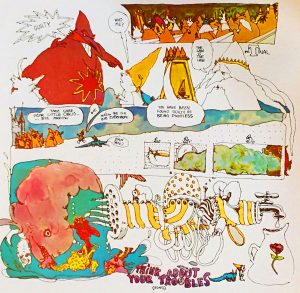
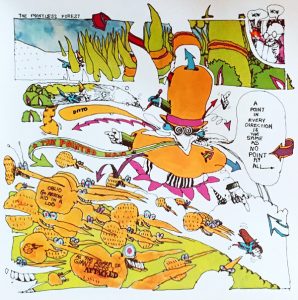

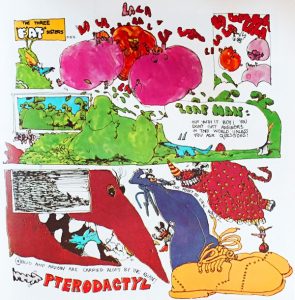

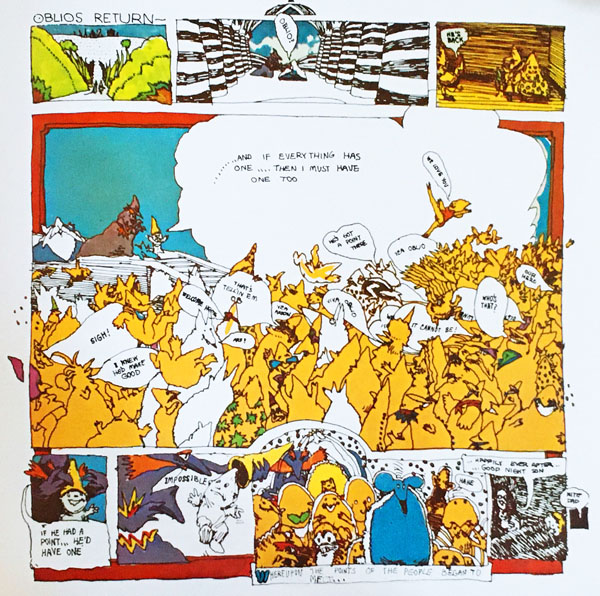
The album design was to have points but no circles, per Nilsson’s instructions. The sales sticker on the shrink-wrap was a triangle. The illustration was hand-stitched in needle “point” by Torrance’s wife, Kathy. Even an exclamation “point” was stitched into the front cover title, though it was seldom punctuated anywhere else, including in the film.
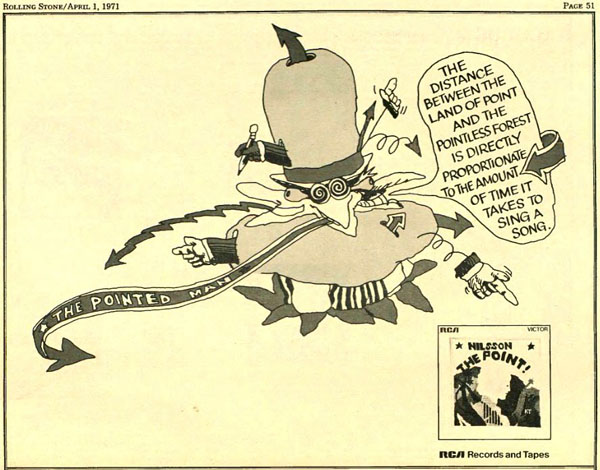
“If I knew how cool my childhood was going to be, I would have paid more attention,” says eternal Brady Bunch kid Mike Lookinland, who also has the distinction of being part of two iconic “points” of popular culture. On the new Blu-ray, TV’s “Bobby Brady” and voice of “Oblio” recalls a memorable chance meeting.
“There was a time in the reception area—it’s sort of like a waiting room in a dentist’s office, you know, you wait in the front to go back to the studio down the hall to record—and my mom and I were waiting for our turn. And I’m making noises. I have a car or something, and I’m going ‘REEERRRR!’ CRRRRRRSSSSH!’ And train noises or whatever. My mom said, ‘Michael, shhh! Stop it! Be quiet! And this man stood up, walked over to my mom and said, ‘Lady, don’t ever tell your kid to be quiet. I make my living on sound. I’ve made a good living making noises. Let him make noises.’ She said it was Paul Frees.”
“Are You Sleeping?” – Harry Nilsson
This was one of the tunes that played when RCA ran TV promos to sell the album in stores.
Harry Nilsson’s THE POINT
MCA Records (England) MCD-2826 (12” 33 1/3 RPM LP / Stereo)
U.S. CD Debut – Varese Sarabande 302 067 409 8 (2016)

Micky Dolenz and Davy Jones in “The Point” (1977)
Performers: Davy Jones (Oblio); Micky Dolenz (The Counts Kid, The Leafman); Veronica Clifford (Oblio’s Mom, Balloon Lady); Noel Howlett (The King); Colin Bennett (The Count); Clovissa Newcombe (The Count’s Lady, Pointed Man); Felix Rice (The Rockman); David Claridge (Arrow); Julia Lewis (Oblio’s Girlfriend); Mark Penfold (Pointed Man); Chrissy Roberts (Balloon Lady); Denny Ryder (Pointed Man); Roy Sampson (Oblio’s Dad); Gary Taylor (Balloon Man, New Bird).
“The Point” Songs: “Everything’s Got ‘Em,” “Me and My Arrow,” “Poli High,” “Think About Your Troubles,” “Life Line,” “P.O.V. Waltz,” “Are You Sleeping?” “To Be a King” by Harry Nilsson.
Other Nilsson Songs: “Remember?” (from Son of Schmilsson, 1972); “He’s Leaving Here This Morning (Bath)” (from Aerial Ballet, 1968); “Blanket for a Sail” (from Knnillsson, 1968); “It’s a Jungle Out There” (from Duit on Mon Dei, 1975); “Gotta Get Up” (from Nilsson Schmilsson, 1971) by Harry Nilsson; “Thursday (Here’s Why I Did Not Go to Work Today),” by Harry Nilsson, Dan Kortchmar (from Sandman, 1976).
“Wow! That guy had an enormous amount of influence on a lot of people!” says Micky Dolenz who was along with his fellow Monkees bandmates, a close friend and collaborator (so were The Beatles and numerous other artists of the late ‘60s).
Nilsson’s “Cuddly Toy,” was often seen on NBC’s Monkees series during its peak (then in reruns on CBS Saturday mornings, later syndication, MTV and now on MeTV). He contributed “Daddy’s Song” to the 1968 Monkees feature Head, a tune which was originally inspired by his own father. The exposure of his music, especially on The Monkees’ TV show and records, helped give Nilsson the financial boost to enter music full time.
Before Davy and Micky got The Point, the stage version began in Boston, and the first actor to play Oblio was David Morse (St. Elsewhere) at the age of 18. Several songs were added from various Nilsson albums, including the lilting “Blanket for a Sail.” Nilsson’s version was later included in a Walt Disney Records collection of children’s songs, as well as a televised concert, performed by celebrity artists to benefit the Elisabeth Glaser Pediatric AIDS Foundation.
The London stage version with Davy and Micky was staged at the famed Mermaid Theatre, where it was co-adapted by the theater’s founder, Bernard Miles. Miles played the role of Honest Jonathan in George Pal’s 1948 film fantasy, tom thumb, which we explored in my previous Animation Spin. Everything has a point, though sometimes it might take a while to get to it.
“Me and My Arrow” – Davy Jones
Those familiar with Davy Jones singing the songs Nilsson wrote for The Monkees will surely feel that his singing in the role of Oblio on this London cast album was a kind of destiny.


 GREG EHRBAR is a freelance writer/producer for television, advertising, books, theme parks and stage. Greg has worked on content for such studios as Disney, Warner and Universal, with some of Hollywood’s biggest stars. His numerous books include Mouse Tracks: The Story of Walt Disney Records (with Tim Hollis). Visit
GREG EHRBAR is a freelance writer/producer for television, advertising, books, theme parks and stage. Greg has worked on content for such studios as Disney, Warner and Universal, with some of Hollywood’s biggest stars. His numerous books include Mouse Tracks: The Story of Walt Disney Records (with Tim Hollis). Visit 





















































My brother-in-law hates cartoons. Bugs Bunny, Popeye, the Simpsons — you name it, he can’t stand it. And yet he can quote big chunks of dialogue from “The Point” — a testament to the deep and lasting impression it created.
There was quite a lot of trippy, countercultural animation on TV at this time, most of it in very small doses like commercials. The ones for Wyler’s lemonade and Nesbitt’s orange soda, and the Peter Max anti-smoking spot, were real mind-blowers. I seem to remember a very cool animated shampoo commercial with partial or suggested female nudity. Then there was Saturday morning fare like “Here Comes the Grump”, “Tomfoolery”, and “Mission: Magic”. Too bad Harvey Comics never made an animated series out of “Bunny, Queen of the In-Crowd”. That would have been ZOOVERS!
Now, a stage version of “The Point” starring Davy Jones and Micky Dolenz — yeah, I’d go to London to see that.
Paul — You’re remembering the “make believe” anti-smoking PSA with Gene Wilder’s voice and the Clairol Herbal Essence Shampoo commercials. There was also the Shasta animated spot which is still run now and then, with the trombone and the parade.
My rather unpleasant grandfather hated The Flintstones, so my brother and sister and I would always make sure that, whenever he visited, there were Fred Flintstone toys quietly strewn somewhere around the rooms he entered, just so we could just glance at each other and smile. We even put a Fred float into the pool when he was there. He didn’t notice, but that wasn’t “The Point.”
I was just wondering if you were going to do a 50th anniversary post about this memorable TV movie. My favorite part would be the silly scene with the bush creature (voice by Paul Frees) acting like falling leaves were sellable merchandise. A nice little satire to commercialism.
Also, “The Great Rupert” was released in 1948. “tom thumb” was release till nearly a decade later.
So would the end where Oblio takes off his dunce cap and has a pointed cranium while everybody and everything gets round mean that he’s still a misfit freak?
A one-of-a-kind movie. It’s as though it started out as a bloop single… and ended up as a stand-up inside-the-park home run. Murakami-Wolf never produced anything else so wonderful. Nilsson’s songs were catchy, brilliant and instantly memorable.
At the time I thought, “television has come of age… imaginative stuff like this will become the norm going forward.” Well, I got over that notion in a hurry, but “The Point” still stands.
I would guess that ABC’s Martin Starger couldn’t really picture — like Millard Mitchell’s myopic studio head in SINGIN’ IN THE RAIN — what an enthusiastic Nilsson was trying to sell him, but the exec had doubtless seen YELLOW SUBMARINE, and in any case, this would be something different that just might work. [ABC, perennially the third place network, was always in search of something a little different in those days.]
I must say, the original Dustin Hoffman narration was very, very effective. The later Barzman and Ringo narration work is fine, of course, but Hoffman did a superb job.
George Aliceson Tipton also arranged Paul Williams’ Oscar-nominated score to Brian De Palma’s “Phantom of the Paradise.”
I remember seeing “The Point” on its original airing; other memorable “Movies of the Week” I also saw on first run, in addition to “Duel,” were “Killdozer” (which had a Marvel comic adaptation), “Roll, Freddy, Roll” (Tim Conway trying to set the record for staying on roller skates) and the chilling, if truncated (for the 90-minute time slot), “Bad Ronald.”
Some of you younger readers will never understand how much more more satisfying TV was when there were fewer than 10 channels, and when a TV writer’s objective was to entertain rather than impress with how enlightened the they are and the profound human truths they gleaned in therapy or rehab.
It also may be a surprise to the younger fry what a big deal a 2-D animated TV special could be back in the day.
THANK YOU FOR THIS POST.THIS ONE OF THE MOVIES FROM MY CHIDHOOD.I STILL WATCH NEARLY EVERY YEAR.IT ALWAYS CHEERS ME UP.
The recent blu-ray of THE POINT is a mess. It is taken from a 16mm print and there are splices that cut off dialogue. The previous dvd is actually much better.
Because it’s 16mm, there is grain and flaws, but it is certainly not a mess. I watched it and did not notice any cut-off dialogue, but I could have missed something.
One word of caution to everyone is to not allow the scratchy opening educational logos to indicate the quality of the rest of the film. I’m glad they’re there for historic (and nostalgic) reasons, but they can put one in the mind that the rest of the film is just as messy, and it was not. But it is also not crystalline. digital 35 negative transfer.
According to this recent article in Rolling Stone, this was the best and only available existing version.
“’Considering the condition of the elements we had while a complete restoration proved to be unfeasible, the end result is the best the film has ever looked and we are proud to give fans and collectors the best edition on disc and digital that has ever been created for this classic animated film,’ MVD’s Eric D. Wilkinson said in a statement.”
https://www.rollingstone.com/music/music-news/harry-nilsson-the-point-50th-anniversary-893972/
is the same Carole Beers who served as an inbetweener on Sleeping Beauty, Coonskin, and various other films. or is it a diffrent person
I watched The Point when it was first on and loved it, though the ending always seemed rushed & arbitrary, as if Nilsson had simply run out of ideas and decided to wrap it up. And it’s been a major disappointment that the original Dustin Hoffman narration – far superior and far more appropriate in tone to any other since, in my opinion – has never been commercially available. Many years ago, I found a digital transfer of what appears to be a foreign VHS version with Hoffman’s narration and despite the substandard visuals, it remains a cherished favorite.
I’d think that the blu-ray format would be the perfect opportunity to make ALL the different narrations available via alternate audio tracks. Surely this classic, loved by so many, deserves nothing less.
Thanks for the great post of a sadly neglected gem. This was a big 5th grade water cooler movie at the time and the ABC Movie of the Week was essentially the Netflix of its era; everyone watched it and everyone talked about the more memorable films for months afterward.
Excellent article, thanks!
They should have paid Dustin.
Thanks for this.